Hanging baskets for trailing plants have become increasingly popular due to their ability to add a touch of greenery and elegance to any outdoor space. These versatile containers allow gardeners to showcase their favorite trailing plants, creating a cascading effect that is both visually appealing and space-saving.
Whether you’re a seasoned gardener or just starting out, this comprehensive guide will provide you with all the information you need to select, plant, and care for hanging baskets for trailing plants, ensuring they thrive and beautify your outdoor space for seasons to come.
Hanging Basket Types
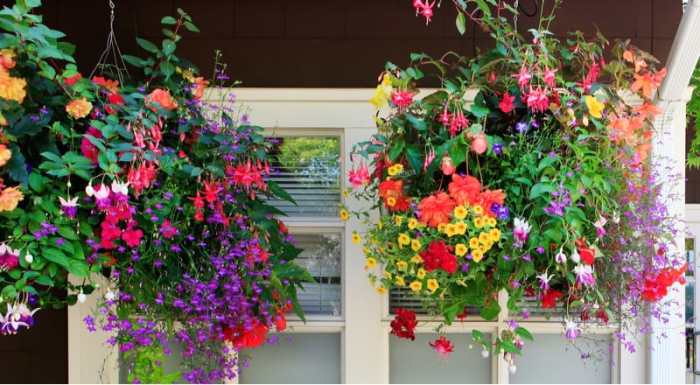
Hanging baskets offer a versatile way to display trailing plants, adding a touch of greenery and elegance to patios, balconies, and indoor spaces. They come in various types, each with its unique characteristics and suitability for different plants.
Materials
Hanging baskets are commonly made from various materials, including:
- Wire: Durable and lightweight, wire baskets allow for good air circulation and drainage.
- Plastic: Affordable and easy to maintain, plastic baskets are weather-resistant and come in a wide range of colors.
- Coir: A natural material made from coconut fibers, coir baskets are biodegradable and provide excellent drainage.
- Metal: Elegant and sturdy, metal baskets add a sophisticated touch and can withstand harsh weather conditions.
- Ceramic: Heavy and delicate, ceramic baskets offer a classic look and are suitable for indoor use.
Shapes and Sizes
Hanging baskets come in various shapes and sizes, from traditional round and oval baskets to more contemporary geometric designs. The size of the basket should be appropriate for the plant’s growth habit and root system.
Smaller baskets are ideal for plants with a compact growth habit, such as trailing succulents or lobelia. Larger baskets are suitable for plants with vigorous growth, such as petunias or trailing geraniums.
Popular Hanging Basket Styles
Some popular hanging basket styles include:
- Coco liner baskets: Made from natural coconut fibers, these baskets are durable, breathable, and provide excellent drainage.
- Self-watering baskets: Equipped with a reservoir that holds water, these baskets reduce the frequency of watering.
- Macrame baskets: Woven from cords, these baskets add a bohemian touch and are suitable for indoor or outdoor use.
- Wall-mounted baskets: Designed to be hung on walls, these baskets save space and create a vertical garden effect.
- Hanging planters: Typically made of ceramic or metal, these planters are suspended from a chain or hook and offer a stylish way to display trailing plants.
Plant Selection for Trailing Baskets
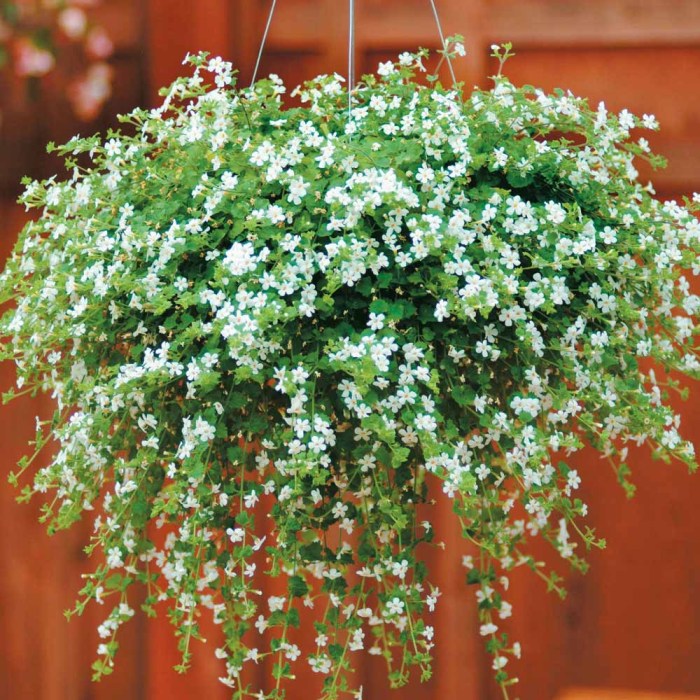
Selecting the right trailing plants for hanging baskets is crucial to create a visually appealing and thriving display. Factors to consider include plant size, growth habit, foliage texture and color, and flowering characteristics.
The number of plants per basket depends on their size and growth rate. Smaller plants, such as lobelia or alyssum, can be planted in groups of 3-5, while larger plants, like petunias or trailing geraniums, may only require 1-2 per basket.
Recommended Trailing Plants
- Lobelia:Compact, mounding habit with cascading blue or white flowers.
- Alyssum:Delicate, trailing habit with fragrant white or purple flowers.
- Petunias:Abundant blooms in various colors and sizes.
- Trailing Geraniums:Vigorous growth habit with showy flowers in shades of pink, red, or white.
- Verbena:Clusters of vibrant flowers in pink, purple, or red.
- Fuchsia:Pendulous flowers with intricate sepals and petals.
- Bacopa:Dense, trailing foliage with tiny white or blue flowers.
- Trailing Snapdragon:Upright spikes of snapdragon flowers in a range of colors.
Planting and Care s
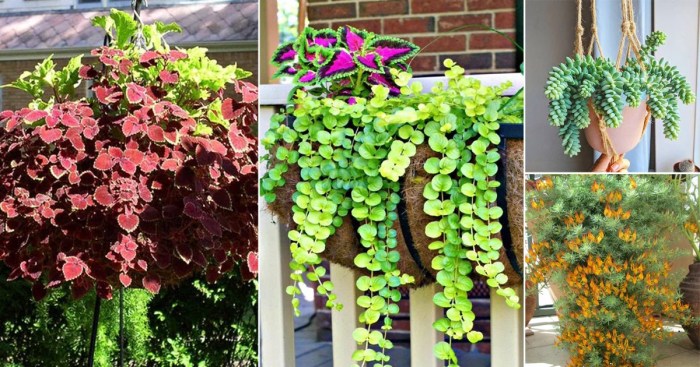
Hanging baskets provide a beautiful way to add color and interest to your patio or balcony. With the right plants and care, they can thrive for many seasons. Here’s a step-by-step guide to planting and caring for trailing plants in hanging baskets:
Soil Preparation:Choose a well-draining potting mix specifically designed for hanging baskets. Add a slow-release fertilizer to the mix according to the manufacturer’s instructions.
Drainage:Ensure the hanging basket has adequate drainage holes. If not, create some using a drill or sharp object.
Planting:Carefully remove the plants from their containers and gently loosen the roots. Dig a hole in the potting mix large enough to accommodate the root ball. Place the plant in the hole and fill it with potting mix, gently firming it around the base of the plant.
Watering:Water the plants thoroughly after planting. Allow the excess water to drain away. Water regularly, especially during hot and dry weather. Check the soil moisture by sticking your finger about an inch deep. Water again when the soil feels dry to the touch.
Sunlight:Most trailing plants prefer partial to full sun. Choose a location that receives at least 4-6 hours of direct sunlight per day.
Fertilization:Fertilize the plants every few weeks during the growing season with a balanced liquid fertilizer diluted to half strength.
Pruning:Regularly prune the plants to remove dead or damaged leaves and stems. This will encourage new growth and keep the plants looking their best.
Design Considerations
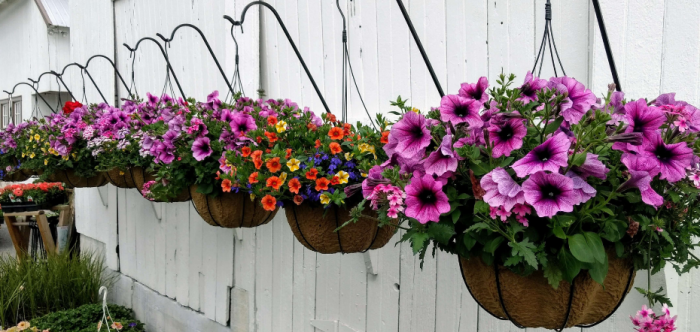
Creating visually appealing hanging baskets requires careful attention to design principles. By considering color, texture, and balance, you can craft arrangements that are both aesthetically pleasing and complementary to your outdoor space.
Color and Texture
The selection of plant colors and textures is crucial in creating a cohesive and visually interesting hanging basket. Consider using complementary colors, such as blue and orange or purple and yellow, to create a striking contrast. Alternatively, opt for a monochromatic scheme with different shades of the same color for a more subtle and elegant look.
Incorporate plants with varying leaf textures, such as glossy and matte, to add depth and interest to the arrangement.
Hanging baskets are an excellent way to display trailing plants, which are often known as “green trailing house plants.” These plants, such as pothos , ivy, and ferns, have long, cascading stems that can add a touch of greenery and elegance to any room.
When choosing a hanging basket for trailing plants, it’s important to select one that is large enough to accommodate the plant’s growth and has adequate drainage holes to prevent waterlogging.
Balance and Harmony, Hanging baskets for trailing plants
Creating a sense of balance and harmony in hanging basket arrangements is essential. Distribute plants evenly throughout the basket to avoid a lopsided appearance. Consider the height and spread of each plant, placing taller plants in the center and trailing varieties around the edges.
By carefully arranging plants with different growth habits, you can achieve a harmonious and dynamic composition that will draw the eye and enhance your outdoor space.
Maintenance and Troubleshooting: Hanging Baskets For Trailing Plants
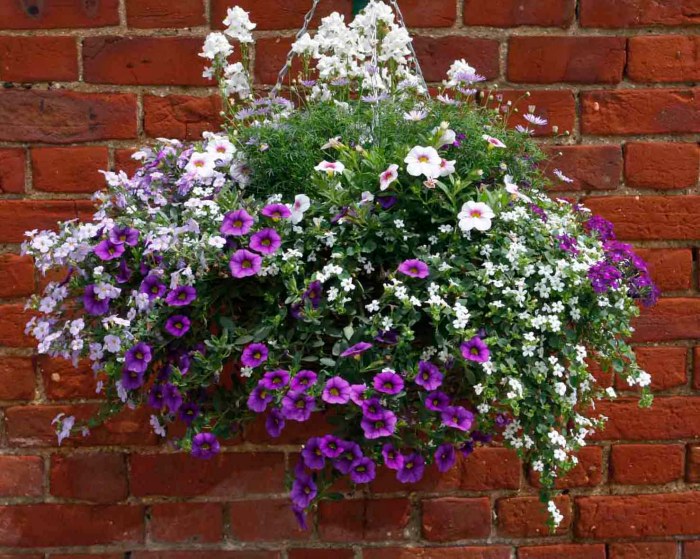
Maintaining the health and beauty of trailing plants in hanging baskets requires ongoing care, including regular watering, pruning, and pest control. Additionally, addressing common problems promptly and implementing seasonal maintenance practices are essential for their well-being.
Watering
Trailing plants in hanging baskets have specific watering needs due to their elevated position and limited soil volume. Regular watering is crucial, especially during hot and dry weather. Allow the soil to dry out slightly between waterings, as overwatering can lead to root rot.
Pruning
Pruning is essential to maintain the shape and vigor of trailing plants. Remove dead or damaged stems and leaves, and trim back overgrown shoots to encourage new growth and prevent overcrowding. Pruning also promotes flowering and fruiting.
Hanging baskets are a popular way to display trailing plants, adding a touch of greenery to any indoor space. If you’re looking for a fuzzy leaf hanging plant, consider the Peperomia scandens . This plant is known for its fuzzy, heart-shaped leaves and trailing stems, making it a perfect choice for hanging baskets.
Pest Control
Hanging baskets can attract pests such as aphids, mealybugs, and spider mites. Regular inspection and prompt treatment are necessary to prevent infestations. Use insecticidal soap or neem oil to control pests organically.
Common Problems and Solutions
Common problems that can arise with trailing plants in hanging baskets include:
- Yellowing leaves:Indicates overwatering or nutrient deficiency. Adjust watering frequency and fertilize regularly.
- Brown or crispy leaves:Signs of underwatering or excessive sunlight. Water more frequently and provide shade during peak sun hours.
- Leggy growth:Caused by insufficient light. Move the hanging basket to a brighter location.
- Wilting:Indicates dehydration. Water the plant thoroughly and increase watering frequency.
Seasonal Maintenance
Seasonal maintenance is important for trailing plants in hanging baskets. In winter, protect them from frost by moving them indoors or covering them with a frost blanket. Repotting is recommended every 2-3 years to refresh the soil and provide more space for root growth.
Hanging baskets for trailing plants are a fantastic way to add a touch of greenery to your home. Whether you’re looking for easy trailing indoor plants like pothos or spider plants, or something more unique, there’s sure to be a plant that’s perfect for your hanging basket.
The key to success is to choose plants that are well-suited to the conditions in your home, and to provide them with the care they need to thrive.
Conclusive Thoughts
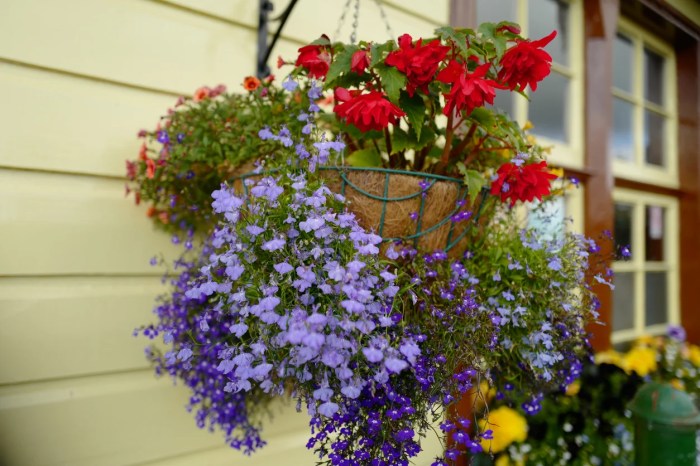
With careful selection, planting, and maintenance, hanging baskets for trailing plants can become a stunning focal point in any garden. By following the tips and techniques Artikeld in this guide, you can create lush vertical gardens that will add color, texture, and interest to your outdoor space for years to come.
Detailed FAQs
What are the best types of plants for hanging baskets?
Trailing plants with cascading or weeping growth habits are ideal for hanging baskets. Some popular choices include petunias, lobelia, verbena, trailing geraniums, and trailing lantana.
How often should I water hanging baskets?
Hanging baskets dry out more quickly than in-ground plants, so they typically require daily watering during hot, dry weather. Check the soil moisture regularly and water when the top inch of soil feels dry to the touch.
How do I fertilize hanging baskets?
Fertilize hanging baskets regularly with a balanced liquid fertilizer. Follow the instructions on the fertilizer label for the recommended application rate and frequency.